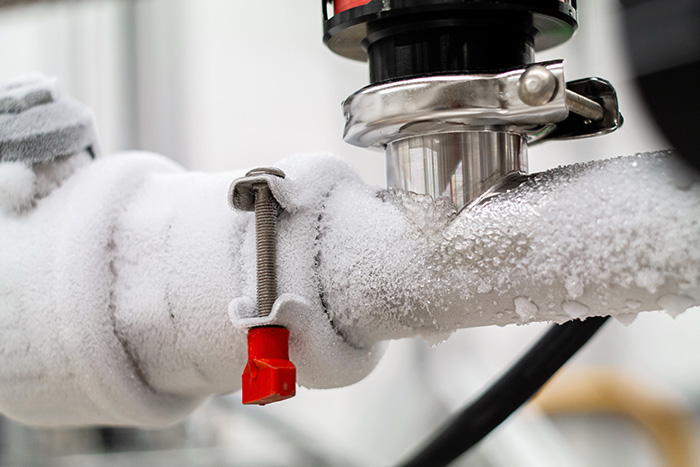Were you on the lookout for advice involving 6 Ways to Prevent Frozen Pipes?

Winter can damage your pipes, especially by freezing pipes. Right here's how to stop it from occurring and what to do if it does.
Intro
As temperature levels decline, the danger of frozen pipelines boosts, possibly causing costly fixings and water damage. Recognizing exactly how to stop frozen pipelines is essential for home owners in cold climates.
Avoidance Tips
Insulating prone pipelines
Cover pipelines in insulation sleeves or use heat tape to secure them from freezing temperature levels. Focus on pipes in unheated or outside areas of the home.
Home heating strategies
Maintain interior areas appropriately heated, especially areas with plumbing. Open cabinet doors to allow warm air to circulate around pipes under sinks.
Exactly how to determine frozen pipes
Look for decreased water circulation from taps, uncommon odors or noises from pipelines, and noticeable frost on revealed pipelines.
Long-Term Solutions
Structural adjustments
Consider rerouting pipelines far from exterior wall surfaces or unheated locations. Add added insulation to attic rooms, cellars, and crawl spaces.
Upgrading insulation
Buy top notch insulation for pipes, attic rooms, and wall surfaces. Proper insulation aids preserve regular temperatures and reduces the threat of frozen pipelines.
Protecting Outside Plumbing
Garden hoses and outside faucets
Separate and drain yard hoses before winter months. Install frost-proof faucets or cover exterior faucets with protected caps.
Recognizing Icy Pipes
What causes pipes to ice up?
Pipelines ice up when exposed to temperatures below 32 ° F (0 ° C) for prolonged durations. As water inside the pipelines ices up, it increases, putting pressure on the pipeline wall surfaces and possibly creating them to break.
Threats and problems
Icy pipelines can cause water disturbances, residential or commercial property damage, and expensive repair services. Ruptured pipes can flood homes and cause considerable architectural damages.
Signs of Frozen Pipes
Recognizing icy pipes early can prevent them from breaking.
What to Do If Your Pipelines Freeze
Immediate activities to take
If you think icy pipelines, keep taps available to relieve stress as the ice melts. Make use of a hairdryer or towels soaked in warm water to thaw pipes slowly.
Conclusion
Stopping frozen pipelines requires positive measures and fast responses. By comprehending the reasons, indications, and safety nets, property owners can secure their plumbing throughout cold weather.
5 Ways to Prevent Frozen Pipes
Drain Outdoor Faucets and Disconnect Hoses
First, close the shut-off valve that controls the flow of water in the pipe to your outdoor faucet. Then, head outside to disconnect and drain your hose and open the outdoor faucet to allow the water to completely drain out of the line. Turn off the faucet when done. Finally, head back to the shut-off valve and drain the remaining water inside the pipe into a bucket or container. Additionally, if you have a home irrigation system, you should consider hiring an expert to clear the system of water each year.
Insulate Pipes
One of the best and most cost-effective methods for preventing frozen water pipes is to wrap your pipes with insulation. This is especially important for areas in your home that aren’t exposed to heat, such as an attic. We suggest using foam sleeves, which can typically be found at your local hardware store.
Keep Heat Running at 65
Your pipes are located inside your walls, and the temperature there is much colder than the rest of the house. To prevent your pipes from freezing, The Insurance Information Institute suggests that you keep your home heated to at least 65 degrees, even when traveling. You may want to invest in smart devices that can keep an eye on the temperature in your home while you’re away.
Leave Water Dripping
Moving water — even a small trickle — can prevent ice from forming inside your pipes. When freezing temps are imminent, start a drip of water from all faucets that serve exposed pipes. Leaving a few faucets running will also help relieve pressure inside the pipes and help prevent a rupture if the water inside freezes.
Open Cupboard Doors
Warm your kitchen and bathroom pipes by opening cupboards and vanities. You should also leave your interior doors ajar to help warm air circulate evenly throughout your home.

I ran across that review about How To Avoid Freezing Pipes while doing a lookup on the search engines. If you enjoyed reading our post please don't forget to pass it around. Thanks a bunch for being here. Come back soon.
Instant Quote
 Neve Campbell Then & Now!
Neve Campbell Then & Now! Judd Nelson Then & Now!
Judd Nelson Then & Now! Michael Bower Then & Now!
Michael Bower Then & Now! Suri Cruise Then & Now!
Suri Cruise Then & Now! Kerri Strug Then & Now!
Kerri Strug Then & Now!